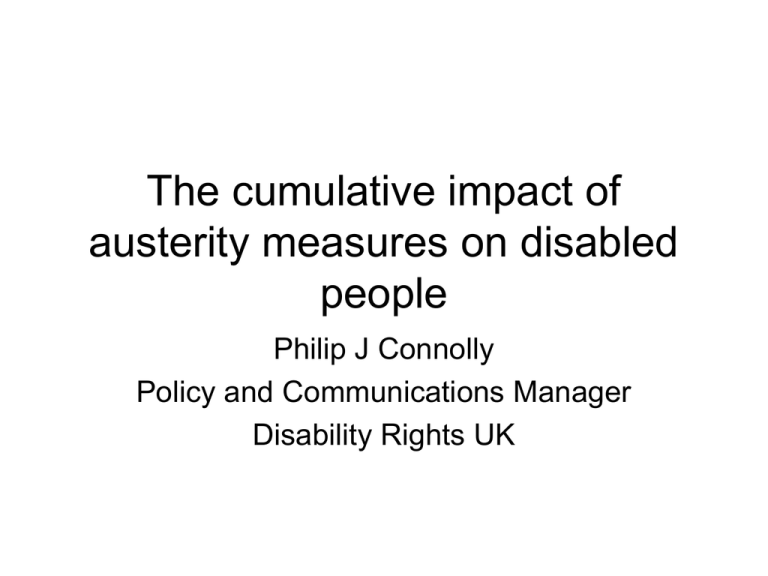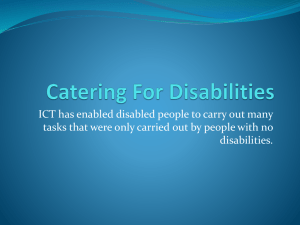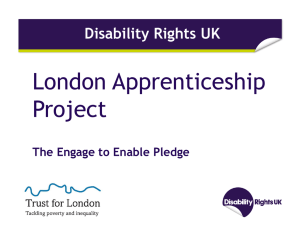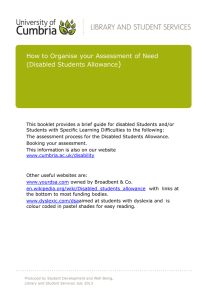The cumulative impact of austerity measures on disabled people
advertisement

The cumulative impact of austerity measures on disabled people Philip J Connolly Policy and Communications Manager Disability Rights UK Cuts from four directions • Housing cuts e.g. bedroom tax • Income cuts e.g. moving from RPI to CPI index linked benefits • Social Care cuts e.g. reduced eligibility against FACS criteria • Public service cuts e.g. extent of disproportionate impact of loss of day care centres etc An example of the journey into destitution • Inappropriately found fit for work following a WCA – 37% of all decisions have been appealed with 23% of these being found in favour of the appellant – DWP data 22/1/14 tables 3 and 4 • Moved from IB to JSA with loss of between a third and a quarter of income • Failure to be offered effective employment support – only 2% of ex IB / ESA people are obtaining work after one year on the Work Programme – data DWP December 2013 – even this masks worse performances for some impairment groups • If placed in the Work Related Activity Group loss of contributory ESA after 12 months • Sanctioned whilst on JSA - of 3 levels, disabled people account for 1 in 5 to 1 in 7 of those sanctioned, some 116,909 sanction decisions in total – data DWP, 20/2/14 • Sanctioned whilst on ESA – 15,276 adverse decisions against disabled people between Dec 2012 and Sept 2013 – data DWP, 20/2/14 • Difficulty in obtaining credit – disabled people are three times more likely to draw on doorstep loans and a half use credit cards or loans to pay for everyday items – Scope, July 2013 • Difficulty in obtaining advocacy or advice – Low Commission, 2014 Some examples of specific issues Work Capability Assessment for Employment Support Allowance • No evidence that criteria (descriptors) make a difference to prospect of work • No concept of what work people with many impairments are being found fit for e.g. blind people • Activities of daily living and observed behaviour tests include many irrelevant indicators of capability for work e.g. running a bath • No consideration of previous work record, educational attainment or availability of jobs or whether employer has instigated reasonable adjustments • No direct linkage between assessment and provision of support to obtain work • Four independent reviews but no evaluation of these criticisms or rationale for the descriptors to date, except for cancer patients Some issues in back to work support • Money - The DWP discussion paper of 17/12/13 stated that the budget for back to work support for disabled people was some £350 million but also noted that there are some 3.6 million economically inactive disabled people – about £100 per person. • Questionable value for money – the prime sub contracting delivery mechanism means that primes borrow money from financial markets against future job outcomes, pay interest on this and then recoup it from management fees. This system means that public money is lost to shareholder dividend and investors leading to reductions in the value that disabled customers can attract such that there is insufficient money to attract the employment support that will make a difference to their job prospects • Black box approach – the client is comparatively well informed regarding conditionality (understanding?) but poorly informed of the support on offer leading to little faith in their own success • Lack of customer choice – no one can currently choose their provider of support • Access to Work – revision of rules appears to be making the support harder to obtain especially for those with an hearing impairment/ fluctuating condition Failure to be attached to a specialist provider • “All of her Providers have, in my opinion, done the barest minimum required of their contacts and just, it would appear, gone through the motions. I feel she has been 'parked' for some time. I think you may be familiar with this term. Every time I have complained that my sister needs a more one to one, structured and interventionist approach to finding work, (particularly, when she entered, in September 2013, her fourth year of being unemployed), I have either been shouted down, ignored or told nobody else has complained so what is your problem; and, when I have complained (after giving the Providers the benefit of the doubt and a good 6 to 12 months lead-time to help my sister), they have, rather conveniently it would appear, dropped my sister as one of their clients”. Deborah Shepherd, email 20/2/14 Available analysis of cumulative impact • “Counting the Cuts” Simon Duffy, 2014 • Citizen Advice Bureau, quarterly trend data • Government departmental data The Centre for Welfare Reform, 2014 Centre for Welfare Reform, 2014 Consequences for everyday living • Energy- - There are 835,000 fuel poor households containing someone with a long term illness or disability, DfE.&C.C.2011 • Debt - In 2010/11, C.A.B. provided advice to more than 72,000 disabled people with debt problems, in September 2013, CAB’s quarterly report noted that rent arrears to social landlords continue to rise and one third of landlord clients advised on possession/eviction were disabled or had a long term health condition • Food - In July of 2013, research by Papworth Trust noted that nine out of ten disabled people were being forced to cut back on food or paying household bills after being refused emergency housing payments to help them pay the bedroom tax • A Disability Benefit Consortium survey quoted in the Times (17/12/13) found that 12% of disabled people were making use of food banks Consequences for hope • “I'm sure you'll have no shortage of responses. I hope, though, that the debate will also emphasise the wider impact on disabled people of the uncertainty and anxiety that the policies are causing. I have in mind the attempt to abolish the Independent Living Fund and the consequent legal battle. We await the Government's next move on this particular issue, but the proposed abolition of the ILF was taken forward despite the 2012 report by the Joint Committee on Human Rights that "reforms to benefits and services risk leaving disabled people without the right to live independently". The JCHR reported that the closure of the ILF, changes in local authority care criteria, the replacement of DLA by PIP and changes to housing benefit risked interacting in a particularly harmful way for disabled people. The JCHR pointed out that some people feared that the cumulative impact of these changes would force them out of their homes and local communities and into residential care.” • Email from Ward Griffiths, parent of a disabled person, 20/2/14 Some thoughts on what is missing • Recognition that the cuts are cumulative and damaging to both individual independence and their interdependence within a socially cohesive society • An employment support plan for the six in every seven who at any one time are not in the back to work system • Investment in peer to peer support for all especially those not in work • Choice and control in obtaining personalised employment support • TRUST Real lives – what our members tell us • As a housebound, mainly bedbound chronically ill woman aged 54, I can confirm that these cuts have been devastating. • Not only to me, but to so many of my disabled friends. Trying to exist on extremely low income, with no hope of moving out of poverty, and living in constant pain, we are heroes to actually survive this atrocity. • The bedroom tax has pushed us into poverty. We go without food and heating and have no hope. Life is incredibly hard. We need to use food banks. • Incredibly strict, and unfair changes, to ESA and to DLA/PIP have led to much hardship and made us more ill. • The extra costs that come with disability and chronic illness are being totally disregarded by this Government. • JOAN. Ruislip. Middlesex. Supporting disabled people in your constituency Disability Rights UK 12 City Forum 250 City Road London EC1V 8AF 0207 250 3222 enquiries@disabilityrightsuk.org











